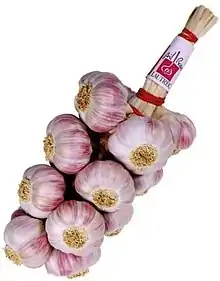Lautrec Pink Garlic
Lautrec Pink Garlic[1] is a protected geographical indication indicating a specific production of garlic from the Lautrec commune in the Tarn department in southern France.

This crop has been, since 1966, listed under the French Label Rouge "ail rose" (pink garlic) [2] and under the protected geographical indication ail rose de Lautrec (Lautrec Pink Garlic) since June 12, 1996.[3]
Characteristics
Lautrec pink garlic is characterized by its pink tunicas,[4] its extended dormancy (allowing its delayed marketing until spring) and by its rigid floral stem that produces clusters of garlic (called "manouilles") instead of braids as with traditional garlic.[5]
The garlic has a highly developed flavor. Due to the extended drying time (a minimum of 15 days), it is well-suited to long-term storage.[6]
Geographical delimitation
The geographical area of production of Lautrec pink garlic has been defined taking into account the historical traditions of cultivation and the characteristics of the terroir. It consists of 88 communes in the western part of the Tarn, in a region with clay and limestone soils, watered by the Agout and Dadou rivers.[5]
History
The pink garlic has been popular in Lautrec since the Middle Ages. Stories are told of a wandering merchant who was unable to pay for his meal at a local tavern; he settled his bill with a mysterious pink garlic. The surprised tavern owner decided to plant it and the pink garlic has been common to the area ever since.[7][8]
References
- "Lautrec Pink Garlic". Ail Rose de Lautrec. Syndicat de défense du Label Rouge et de l'IGP Ail rose de Lautrec. Archived from the original on February 3, 2017. Retrieved June 29, 2019.
- "L'histoire de l'Ail Rose de Lautrec". ailrosedelautrec.com (in French). Syndicat de défense du Label Rouge et de l'IGP Ail rose de Lautrec. Archived from the original on February 24, 2017. Retrieved June 29, 2019.
- "Commission Regulation (EC) No 1107/96 of 12 June 1996 on the registration of geographical indications and designations of origin under the procedure laid down in Article 17 of Council Regulation (EEC) No 2081/92". EUR-Lex (in French). Publications Office of the European Union.
- Cianflone, Eugenio (2014). "TEACHING FOOD SCIENCE ENGLISH WITH PRODUCT SPECIFICATIONS". The Journal of Teaching English for Specific and Academic Purposes. 2 (4): 551–558. ISSN 2334-9212. Retrieved January 28, 2017.
- "Fiche "Ail rose de Lautrec"". inao.gouv.fr (in French).
- HASSAN, Daniel; MONIER-DILHAN, Sylvette; RÉQUILLART, Vincent (March 2004). "Développement des pratiques de qualité dans la filière fruits" (PDF). Agreste (in French). CAHIERS N° 2: 35–41. Retrieved January 28, 2017.
- "PINK GARLIC OF LAUTREC". globalveg.fr. 2017. Retrieved February 1, 2017.
- "Lautrec's Pink Garlic history". ailrosedelautrec.com. Retrieved February 1, 2017.
.jpg.webp)